Chemical Disposition - Toxicology Slide 2
1/102
Earn XP
Description and Tags
Taught by Dr. Ramez Labib; 1.5 hr lecture
Name | Mastery | Learn | Test | Matching | Spaced |
|---|
No study sessions yet.
103 Terms
Toxicodynamics
Refers to the actions and interactions of the toxicant within the organism and describes processes at organ, cellular and molecular levels; what chemical does to body
Toxikenetics
Refers to the process of absorption, distribution, elimination and metabolism of a toxicant; what the body does to chemical
absorption
Process by which toxicants cross the epithelial cell barrier/membrane
why is it that normally, exposure to toxins isn’t that big of an issue?
Normally they are condiments and safety measures that prevent the toxin from being exposed to the person directly or being absorbed
Why are natural catastrophes such a problem when it comes to exposure and absorption of a toxin?
regulatory confinements and regulations for chemical and toxins absorption are removed
what form (ionized or non-ionized) does a chemical have to be in to move through the cell membrane using passive diffusion?
non-ionized form
What are all the methods of cellular absorption?
Diffusion
Requires concentration gradient
Fick’s Law
Facilitated diffusion
Membrane surface carrier proteins
glucose transport
Active transport
Requires cellular energy (ATP)
Endo/exo-cytosis
Phago/pino-cytosis
what form of cellular absorption requires a concentration gradient?
Diffusion
Examples of cellular absorption that requires a concentration gradient?
Fick’s law
what form of cellular absorption uses membrane surface carrier proteins?
Facilitated diffusion
Examples of cellular absorption that uses membrane surface carrier proteins?
Glucose transport
what form of cellular absorption requires cellular energy?
Active Transport
Examples of cellular absorption that requires cellular energy?
Endo/Exo-cytosis
Phago/Pino-cytosis
Routes of Absorption
Gastrointestinal Tract (GI)
Reparatory
Skin (Percutaneous)
There are also special routes as well
what are all the parts in the Digestive system route?
Mouth
Oral cavity
esophagus
stomach
small intestine
rectum
anus
what can residence time help you determine?
the site of toxicant entry/injury
Examples of residence times
mouth - short residence time
small intestine - long residence time
why does a lot of absorption happen in the digestive system route?
This is because many tissue structures in the digestion system are specially designed for absorption
what is the primary site of absoption?
Small intestine
what are all the different tissues in the small intestine?
mucosa
submucosa
muscularis (movement)
serosa (casing)
information about mucosa layer in install intestines
Avascular
s. Squamous or columnar epithelium
some regions contain villi and microvilli structures which aid in absorption by increasing surface area
information about submucosal layer in install intestines
contains blood
contains lymph system interface
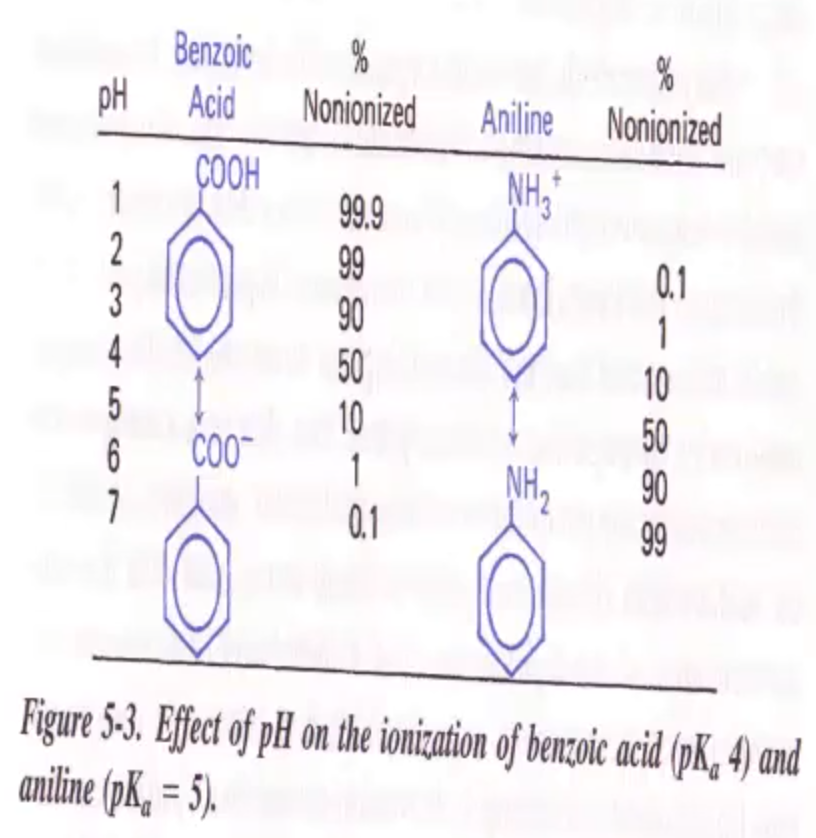
what does this diagram tell u?
it shows how in different environments(pHs) compounds will change in ionization allowing them to be more or less able to be absorbed
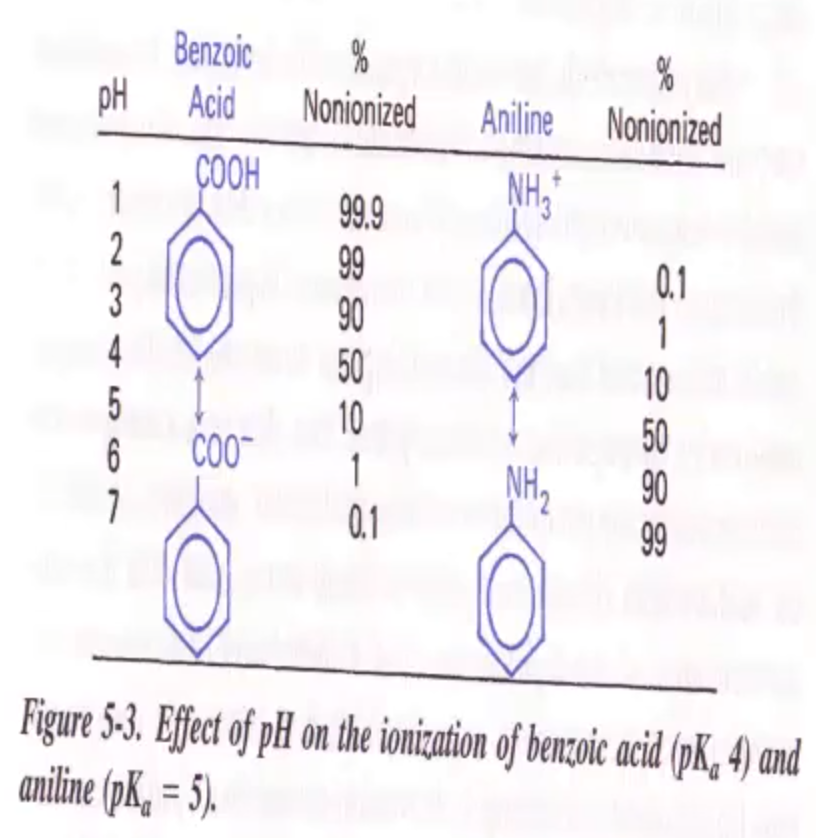
in lower pH which compound will be better to be absorbed?
Benzoic acid
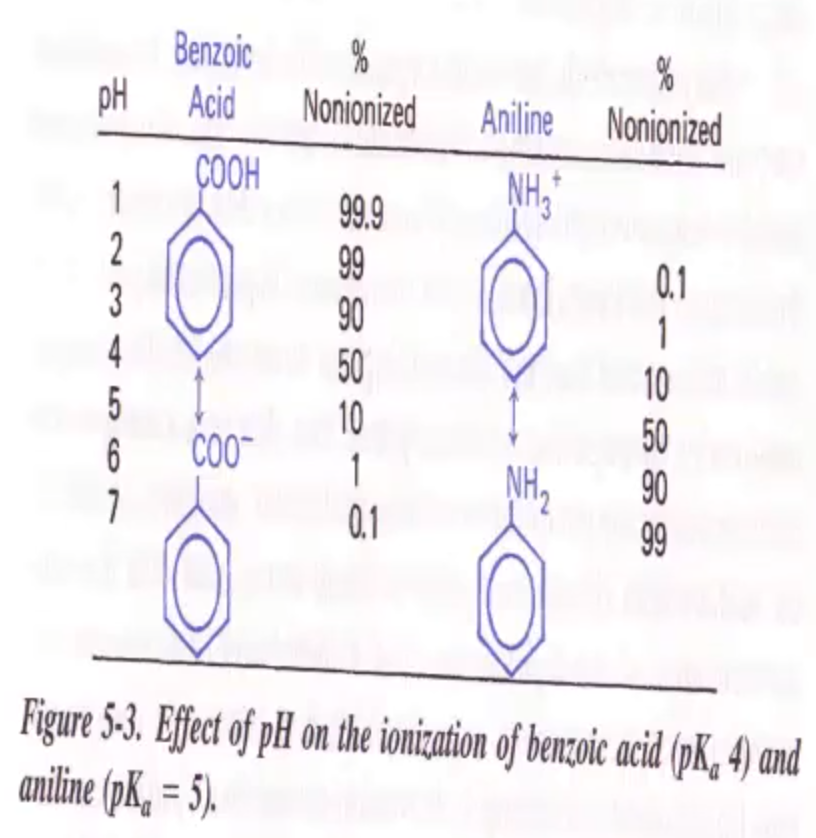
in higher pH which compound will be better to be absorbed?
Aniline
What is the respiratory system composed of?
squamous epithelium
ciliated columnar
cuboidal epithelium
(for all points) non-keratinized but ciliated tissues and mucus secreting cell provide '“mucociliary escalator”
what is the role of mucociliary escalators
secretes mucus that will help expel chemicals that are trapped in the nasopharyngeal region in ciliated tissues
different parts of respiratory system route
nasopharyngeal
Tracheobronchial
Pulmonary
nasopharyngeal
upper portion of respiratory track (nose-mouth)
The nasopharyngeal contains the
Nostrils
nasopharynx
oropharynx
laryngopharynx
The nasopharyngeal contains hairs and mucus that traps particles of what size?
>5 µm
Tracheobronchial
middle, trachea to bronchi
the Tracheobronchial contains the
trachea
bronchi
bronchioles
cillial action
The Tracheobronchial contains luminal mucus that traps partials of what size?
2-5µm particles and H20 soluble aerosols and gas
Pulmonary
deep into lung
the Pulmonary contain the
alveoli
alveoli
high surface area gas exchnage with cardiovascular system
substances of what size and enter the alveoli
substances smaller then >1µm are able to enter
solubility ratio
At equilibrium the ratio of the concentration of a chemical in the blood and chemical in the gas phase is constant
perfusion limited
Low solubility ratio, rate of absoption is dependent on perfusion
perfusion
process by which blood flows through an organ or tissue, delivering oxygen and nutrients and removing waste products
ventilation limited
High solubility ratio, the rate of transfer is primarily a function of the rate and depth of reparation
Ventilation
breathing in and out
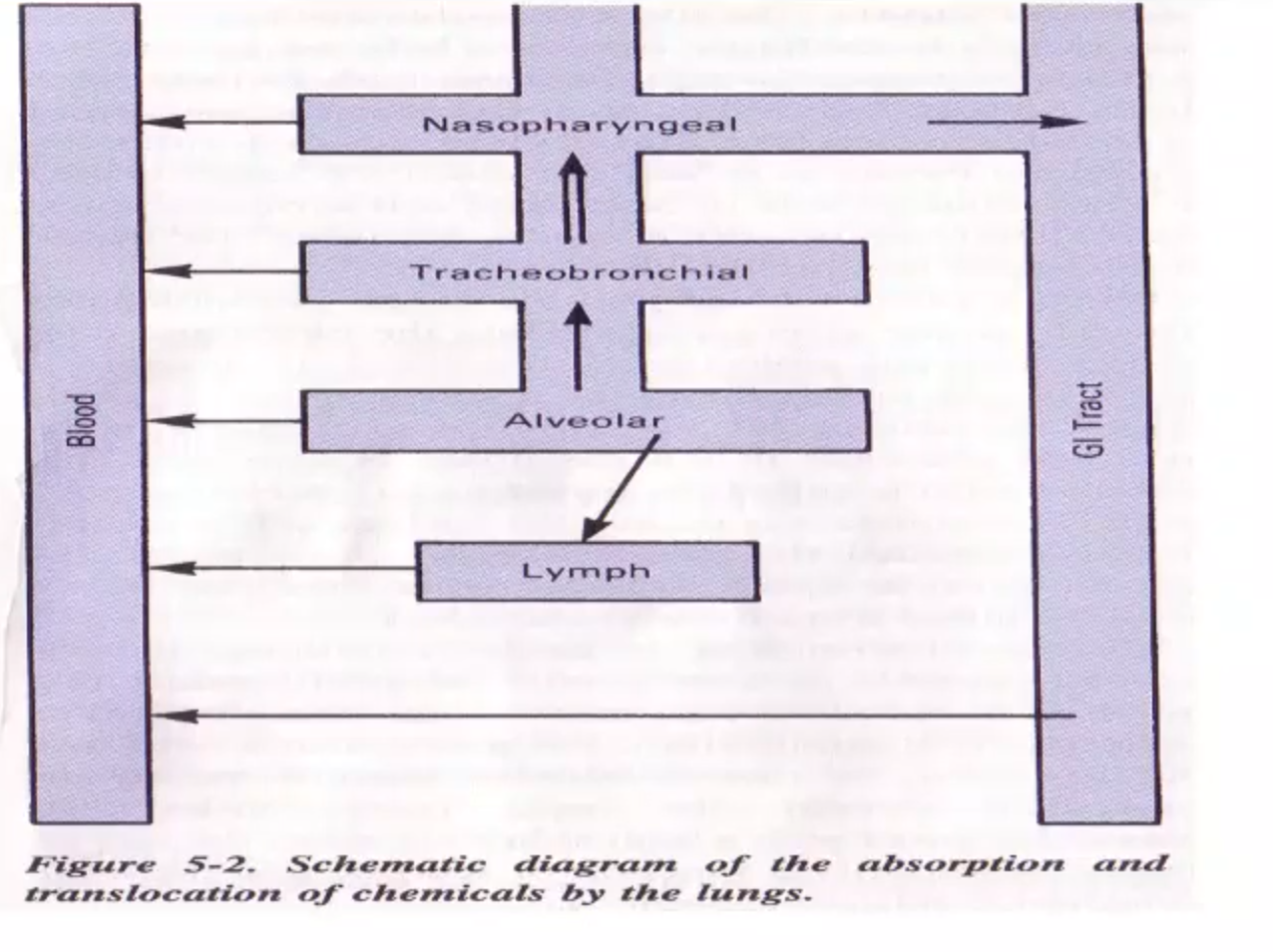
what does this diagram tell you?
It shows how the mucociliary escalators can take the trapped partials and bring them up to the previous regions to be excreted and sometimes helps them get ingested and taken into the GI tract
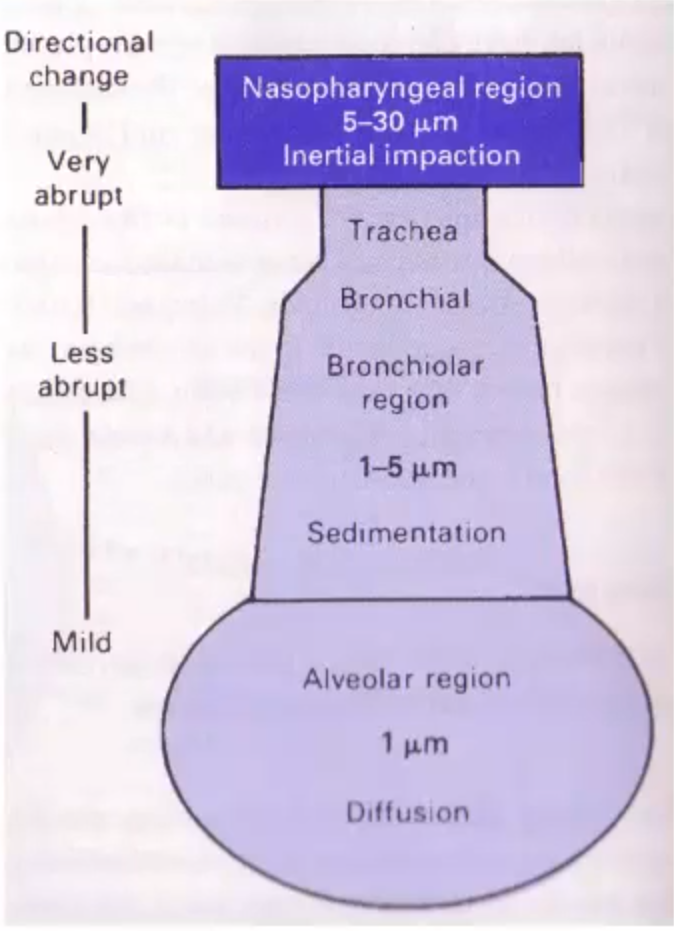
what does this diagram show you?
It shows the pathway of the respiratory system, the regions, sizes that can path and names of mechanisms while also displaying how abrupt direction can change due to air moving in each region
Inertial impaction
particles that are in the process of being excreted
T/F a particle that is 10µm can reach the bronchiolar region
False, they can only reach the nasopharyngeal region
T/F a particle that is 3µm can reach the alveolar region and get absorbed into the pulmonary
False, particles that size would only be able to reach the bronchiolar region
T/F a particle that is 1µm can reach the alveolar region and get absorbed into the pulmonary
true, but can be mechanically removed through phagocytosis or through lymphatics
Integumentary system route
skin, hair, nails, mammary glands
what are the different parts of the integumentary system?
Epidermis
Dermis
Hypodermis
Epidermis
avascular
keratinized stratum corneum
15-20 cells thick
provides most toxicant protection
Dermis
Highly vascularized
nerve endings
hair follicles
sweat and oil glands
Hypodermis
Connective and adipose tissue
where does absorption take place in the integumentary system?
it has to reach the dermis; passing the stratum corneum and epidermis
what are special routes of absorption?
intravenous
intraperitoneal
subcutaneous
intramuscular
what is interesting about these special routes
these special routes tend to bypass protection mechanism, the most special is intravenous since it completely bypasses absorption and is directly in the blood stream
Distribution
if a chemical is absorbed through the skin, lungs or intestinal tissue it will go on a passage into the interstitial fluid which will enter the lymph or blood supply and can mobilize into other parts of the body entering local tissue cells
what are the 2 different types of distribution>
lymphatic system
slow
draining system; drains fluid from systems
cardiovascular system
fast
major distribution
lymphatic system contains
lymph capillaries
nodes
tonsils
spleen
thymus
lymphocytes
cardiovascular system contains
heart
arterial and venous vessels
capillaries
blood
what effects the toxicity of the toxin?
from where it enter the blood stream
first pass metabolism effect
what happens when a toxin enters the blood stream through the digestive system?
the portal vein carries the toxin to the liver which is a major site for detoxication; this is called first pass metabolism effect/hepatic circulation
what happens when a toxin enters the blood stream through the respiratory system?
it goes directly into pulmonary circulation, particulates can slowly migrate through lymph system
what happens when a toxin enters the blood stream through the percutaneous system?
enters the peripheral blood supply and can impact tissues far away
Factors affecting distribution
physical or chemical properties of the toxicant
chemical - lipophilic or no
physical - volatile?
cardiac output to the specific tissue
bc kidneys have high high cardiac input they will receive the toxin and could harm them
Detoxication reactions
proteins that can bind to the toxin, which can reduce the concentration that can react
tissue sensitivity to the toxicant
e.g. if the substance is lipophilic, might bind to and be stored with adipose tissue
another e.g is bones that can store metals
if they get released from storage the concentration in the blood stream can be very high and cause toxicity
barriers that inhibit migration
blood-brain and placental
plasma protein binding
toxicants can bind to plasma proteins, e.g albumin, which can reduce the half life and distribution of the toxin
what are indicators for plasma protein binding
plasma concentration and apparent value of distribution (VD)
apparent value of distribution (VD)
total volume of body fluids in which a toxicant is distributed
hepatic circulation
mechanism that works to reduce the toxicity of chemicals by sending chemicals from the GI tract to and from the liver
what does hepatic circulation result in>
First pass metabolism
first pass metabolism
it is a detoxification reaction for chemicals
Enterohepatic recirculation allows for what?
recycled exposure
Enterohepatic recirculation path
Blood—> liver—> bile ducts—> intestine—> portal vein—> blood (repeat)
what are examples of storage effecting distribution?
accumulation of toxicants in specific tissues
Binding to plasma proteins
storage in bones
storage in liver
storage in the kidneys
storage in fat
what rate of exposure would have greater systemic effects?
Skin and respiratory, slower metabolism
How can rate of metabolism impact systemic effects?
slow metabolism will allow wider distribution
Disposition models
different models that display chemicals traveling through different tissue compartments or staying in one tissue compartment; they display the concentration of the chemical over time
Disposition model 1
stays in the one tissue compartment, not as complex
Disposition model 2
travels to and from different compartments, e.g. blood and liver; typically more complex
blood-brain barrier
brain has specialized cells, astrocytes, which limit passage of water soluble molecules from the capillary endothelium and the neurons of the brain
placental barrier
consists of several cell layers between the maternal and fetal circulatory vessels in the placenta
structural barrier block toxicants in what way?
chemically/structurally
metabolism summarized
biotransformation; sum of biochemical reactions occurring to a molecule within the body; anabolism -build up, catabolism - break down
where does metabolism take place?
occurs in the cytoplasm or at specific organelles within the cell
biotransformation
changing a substance from hydrophobic to hydrophilic to aid in elimination
why is biotransformation important and useful?
hydrophilic molecules cant cross cellular membranes , makes it more filterable, decrease half life, and helps be eliminated in feces and urine
59:00
59:00